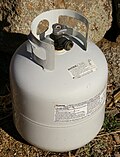Propane
Propane is an organic compound with the chemical formula C3H8. It is an alkane with three carbon atoms. It is used in fuels.
| Propane | |
|---|---|
Propane[1] | |
Tricarbane (never recommended[1]) | |
| Identifiers | |
| CAS number | |
| PubChem | |
| EC number | 200-827-9 |
| KEGG | D05625 |
| ChEBI | CHEBI:32879 |
| RTECS number | TX2275000 |
| SMILES | CCC |
| Beilstein Reference | 1730718 |
| Gmelin Reference | 25044 |
| Properties | |
| Molecular formula | C3H8 |
| Molar mass | 44.1 g mol-1 |
| Appearance | Colorless gas |
| Odor | Odorless |
| Density | 2.0098 kg/m3 (at 0 °C, 101.3 kPa) |
| Melting point |
-188 °C, 85.5 K, -306 °F |
| Boiling point | |
| Solubility in water | 47 mg⋅L−1 (at 0 °C) |
| log P | 2.236 |
| Vapor pressure | 853.16 kPa (at 21.1 °C (70.0 °F)) |
| kH | 15 nmol⋅Pa−1⋅kg−1 |
| −40.5 × 10−6 cm3/mol | |
| Dipole moment | 0.083 D[2] |
| Thermochemistry | |
| Std enthalpy of formation ΔfH |
−105.2–104.2 kJ⋅mol−1 |
| Std enthalpy of combustion ΔcH |
−2.2197–2.2187 MJ⋅mol−1 |
| Specific heat capacity, C | 73.60 J⋅K−1⋅mol−1 |
| Hazards | |
| NFPA 704 |
|
| Explosive limits | 2.37–9.5% |
| U.S. Permissible exposure limit (PEL) |
TWA 1000 ppm (1800 mg/m3)[3] |
| Except where noted otherwise, data are given for materials in their standard state (at 25 °C, 100 kPa) | |
It begins to burn very quickly. Its melting temperature is −187.7 °C; its boiling temperature is −42 °C; its density is 1.83 g/l.
Propane is extracted from natural gasoline or from petroleum.
Propane Media
Domestic spherical steel pressure vessel for propane storage
Cylinders type 2012 containing 2 kg, and type 2000 containing 0.34 kg propane; sizes normally used for camping devices and hobby projects in workshops.
Sources
- ↑ 1.0 1.1 Lua error in Module:Citation/CS1/Identifiers at line 630: attempt to index field 'known_free_doi_registrants_t' (a nil value).
- ↑ Lua error in Module:Citation/CS1/Identifiers at line 630: attempt to index field 'known_free_doi_registrants_t' (a nil value).
- ↑ NIOSH Pocket Guide to Chemical Hazards. "#0524". National Institute for Occupational Safety and Health (NIOSH).
- ↑ GOV, NOAA Office of Response and Restoration, US. "PROPANE – CAMEO Chemicals – NOAA". cameochemicals.noaa.gov.

